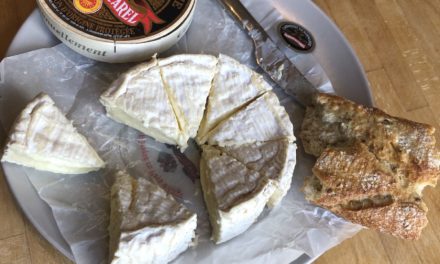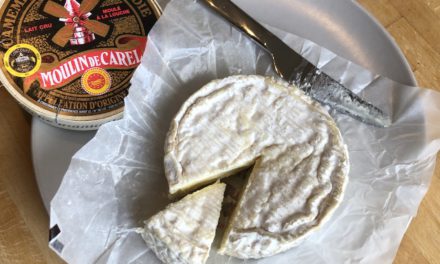First, what is a Comté cheese? In case you don’t know, you can read all about what Comté PDO cheese is in the article “Everything you need to know about French Comté Cheese“. But a short description is as follows:
Comté PDO cheese is a cooked pressed cheese. Its paste is firm and ivory to yellow in color, in the case of more mature cheeses it may contain tyrosine crystals (an amino acid). Comté PDO cheese contains between 45 and 54 grams (1,6 and 1,9 ounces) of fatty matter per 100 grams (3,53 ounces) of cheese in dry extracts.
Formerly known as the “Gruyère de Comté”, Comté PDO cheese has now become one of the main prides of the hexagon. This is thanks to its versatility to be enjoyed in different dishes, as we will see below.
What does Comté cheese taste like?
A young Comté PDO cheese will have a milkier taste and aromas, while more mature cheeses can have fruitier (citrus and hazelnut) and smoky flavors.
Thanks to cooperative production, despite following the same production rules, the cheeses will always have their own personality according to the “fruitière” that makes them, either because of the microclimate of the surrounding farms, the season or even thanks to the slight variations that each cheesemaker makes during production.
Is it possible to eat the rind of Comté cheese?
In the case of Comté PDO cheese, the rind around the cheese is not usually eaten.
It should be removed from your portion once it has been served on your plate. We do not recommend you remove the rind from the whole cheese if you do not think you are going to eat it completely, as it helps to preserve it better. An interesting fact about the rind is that it varies from golden to brown in color according to the cellar in which it was matured and the length of time it has been matured.
How is Comté cheese served?
Like many foods, Comté PDO cheese should not be eaten straight out of the fridge. We recommend that you let it come to room temperature for a few minutes.
Then, in the case of Comté PDO cheese, you can use any traditional, flat, non-serrated knife to cut it, but I recommend using a knife designed for cutting cheese.
If you are cutting it from the cheese wheel, the French cut it similar to a round cake, i.e. from the centre of the cheese to the outside in rectangular portions. I recommend you watch this video which explains it perfectly.
Now, if you are cutting into your portion of cheese, you will have to cut it in equal portions transversally, until you are close to the origin of the cheese, in this case you will change direction again and start cutting it longitudinally. The objective of this methodology is that each cut can have a part of cheese that is sufficiently appreciable at the time of tasting it. In this video you can see how the lady who narrates it cuts it.
Once it has been cut in this way, you can serve it to your guests and serve it as you wish!
What to pair Comté cheese with?
Comté PDO cheese has a lot of versatility, if we want to eat it like the purists, we can pair it with a good wine and a piece of good baguette bread. Now if we want to start experimenting a bit we can pair it with nut bread or baguette with grains.
When it comes to wine, the locals recommend pairing it with wines from the region, as you might have guessed. The wines of the Jura, among which we can mention one of the most famous wine villages, Arbois, pair perfectly with the wine. If you are looking for more options to mention a few wines, you can pair it with:
- Châteauneuf-du-pape blanc
- Champagne
In this video we can see different wines with which you can pair Comté PDO cheeses according to their maturation time.
If wines are not your thing or you are simply in the mood for beer, then you can use blonde beers. At the end feel free to experiment, you can accompany it with vanilla ice cream, tea or even Griottines (cherries macerated in alcohol).
However, if you ask me how I prefer to eat Comté PDO cheese, my answer will always be in a Fondue. I will leave you with one of the best recipes I have ever tasted in my life, from the restaurant La Finette in the village of Arbois in the Jura department. This village is not only in the region of Comté PDO cheese production, but it is also a region of French wine production, so using both local products makes the perfect mix.

With this recipe you can prepare it at home, with simple ingredients, a large crushed garlic, black pepper, 250 grams (8,8 onces) of Comté PDO cheese per person, you can choose from different ages to make a mixture of flavours, 10 months, 14 and 16 months and half a glass of white Chardonnay wine per person. This delicious Fondue can be served with cold meats, French pickles and green salad. Something interesting at the end of the fondue is that the locals add a raw egg to cook it with the rest of the cheese, a real delicacy!
Is it safe to eat raw Comté cheese?
Yes, it is totally safe, it is not necessary to cook it or melt it in order to eat it.
Although Comté PDO cheese is very versatile to be added to different dishes as we saw before, in fact the French in the region usually eat it raw with a good piece of baguette bread, accompanied by wine.
Although consumption is entirely suitable for healthy adults. The health authorities recommend that fragile people do not consume raw milk or raw milk cheese. Fragile people include:
- Children under 5 years of age.
- Pregnant women.
- Immunocompromised persons.
More details can be found on the website of the “Ministère de l’agriculture et de l’alimentation“.
How nutritious is Comté cheese?
Comté PDO cheese is particularly rich in protein, calcium, phosphorus, copper, zinc, vitamin A and B12 and is a source of vitamin B2. It is also low in salt, 0.8 grams (0,03 ounces) per 100 grams of cheese. Per 100 grams (3,5 ounces) of cheese we have 26,7 grams (0,94 ounces) of protein, 34,6 grams (1,22 ounces) of lipids, 0 grams (0 ounces) of carbohydrates, 36,2 grams (1,21 ounces) of water, 2,5 grams (0,08 ounces) of minerals and 800 mg of calcium.
When is the ideal time to eat Comté cheese?
Comté PDO cheese is recommended to be consumed from August to March.
This is because, as we mentioned in the article, “Everything you need to know about French Comté Cheese“, Comté PDO cheese is matured for a minimum of 4 months and can last up to 24 months. Therefore, the best cheeses begin their process in spring and summer, when the cows can consume the most fresh grass and all the natural variety of flowers. Taste will not be the only variation, when the milk is from spring or summer the end result of the cheese will have a strong yellow colour, whereas, if the milk is from autumn or winter, the colour will vary to a paler cheese. It is worth mentioning that the cheese does not allow the addition of any colouring agents, so its yellow colour is a colour it develops naturally.
How much lactose is in Comté cheese?
Great for those who are lactose intolerant, its presence is minimal allowing you to consume it with peace of mind. According to the “Association Française des intolérants au lactose”…
Comté PDO cheese contains less than 0.3 grams (0.01 ounces) of lactose per 100 grams (3,53 ounces) of cheese.
How do I know if Comté cheese is still good to eat?
In the case of Comté PDO cheese, it is a cheese that will continue to mature as long as we store it at home. However, as we have removed its protective rind, if we store it in a slightly humid place, it may develop white mould on the surface, in which case, although some people remove the mouldy part and eat the rest, it is recommended not to eat it and to throw it away immediately.
Generally, to determine if a cheese is in good condition for consumption, it is simply to observe, smell and taste the product, if we consider that it is still good according to its normal characteristics, we can consume it without any problem. However, we can also be guided by the expiry dates indicated on the packaging of the product and the conservation guides after opening as indicated on the label.
Are you ready to taste the springtime of the Jura mountains? Let Comté PDO cheese introduce you to its native region.
Enjoy your trip!





